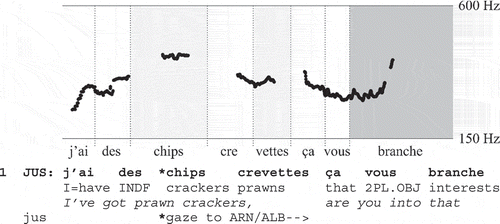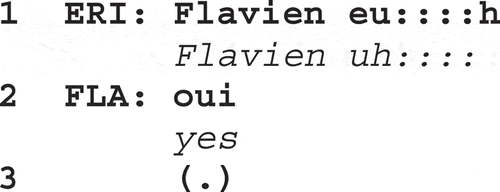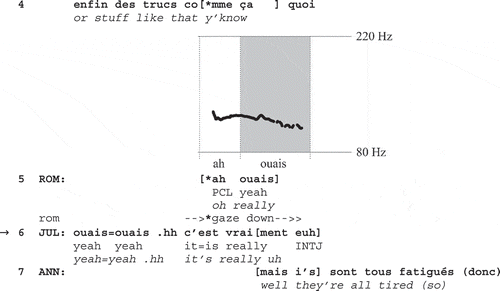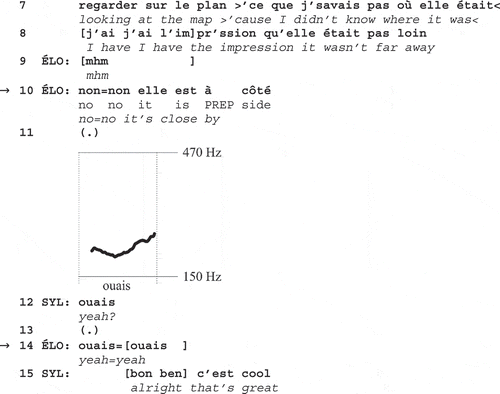ABSTRACT
This article examines three practices in responses to polar questions in French: prefacing a polar response token (e.g., oui [“yes”] or non [“no”]) with the particle ah (e.g., ah oui), prefacing with the particle ben (e.g., ben oui), and producing more than one token (e.g., oui=oui). The analysis suggests that such responses serve to take issue with the question; specifically, respondents display the answer to be obvious or redundant, challenge the questioner’s unknowing stance, or disalign with the further action implications of the question while still providing a polar answer. Comparisons are made with other practices for exerting agency in responses and with resources described for other languages. The resources available in French help participants differentiate in which way the respondent takes issue with the question, notwithstanding significant local particularization by reference to the specific question and its context. Data are in French, with English translation.
Question-answer pairs are an essential locus of microlevel social organization, constituting a pervasive and fundamental sequence-organizational format that underpins a vast range of social activities. The respondent in a question-answer sequence is constrained to acting within a tightly organized normative structure involving projections and expectations as well as consequences that will follow any departure from what is expected. This is particularly clear for polar questions, where (in many languages) respondents are normatively expected to produce an item from a very limited set of polar response tokens.
Conversation-analytic research is beginning to map the resources that respondents have for exerting social-interactional agency and asserting their own agenda or perspective. One method for departing from the constraints of a polar question is to provide a response that is not type-conforming, i.e., one that does not involve some form of a polar response token such as yes/no in English, or oui/non in French, and thus does not follow the normative response requirements imposed through particular question types (G. Raymond, Citation2003). With nonconforming responses, respondents can thus, e.g., answer the question while adjusting the terms, answer the question while correcting its presuppositions, or evade the question altogether. Nonconforming responses are a vital resource for embodying agency and carry with them their own implications of inferences that questioners can (and do) draw upon receipt of such responses. However, previous work has also shown that even type-conforming responses can be used in such a way as to allow the respondent a more agentive role in the emerging sequence and activity. This article examines three such practices, and I argue that respondents deploy them to take a stance toward a question while answering it by prefacing a polar response token (e.g., oui [“yes”] or non [“no”]) with either of the two particles ah and ben or by producing two or more instances of the same polar response token together (e.g., oui=oui). Respondents can thus perform additional interactional work beyond (dis)confirmation while still “going along” enough to provide an answer in the form of a (dis)confirmation of the proffered hypothesis. By comparing three different practices for doing similar work, this article examines to which extent different practices can be specialized to communicate precisely what the respondent’s issue with the question is and to which extent such specification is a product of the particulars of the question and its context.
Background
Responsive actions in talk-in-interaction have attracted substantial interest in conversation-analytic research, and respondents have numerous resources at their disposal for resisting, deflecting, or countering other participants’ initiating actions and the sequential trajectories they project (see Lee, Citation2013, for an overview). This review focuses on responses to polar questions and content questions (“wh-questions”) (but see Sorjonen, Citation2001; Thompson et al., Citation2015, for studies of second actions responding to a range of initiating actions).
While questioners can impose strong constraints on the next turn, respondents do not always simply provide the elicited response but have means for “pushing back” against the asking of a question or its phrasing. Besides not responding or doing a nonanswer response, one method for “pushing back” is to provide nonconforming or transformative responses, i.e., responses taking other form than polar response tokens where such responses are called for (G. Raymond, Citation2003; Stivers & Hayashi, Citation2010). Similarly, in response to content questions, where unproblematic answering is done by providing called-for phrasal responses, clausal responses serve to treat the question or its agenda as problematic (Thompson et al., Citation2015, pp. 16–49). Polar questions provide a particularly clear illustration of the strength of constraints posed on prospective answerers, since they not only establish what is required action-wise for the next turn to count as a satisfactory second pair-part but also heavily narrow down which form the response should normatively take, i.e., an item from the strongly limited set of polar response tokens, in languages such as English (G. Raymond, Citation2003) and French.
These narrow constraints are so powerful that even wholly confirming answers can be inferentially implicative if taking some other form than a polar response token, e.g., full or partial repetition of the question (Enfield & Sidnell, Citation2015; J. Heritage & Raymond, Citation2012). With such repetitional confirmation (e.g., Have your visitors gone? – They’ve gone.), answerers exert agency with respect to the setting of the question’s terms and assert more authoritative knowledge of the matter than the questioner conceded (since repetitions have greater indexical independence from the question than response tokens do). In several languages, confirmation through repetition, rather than through polar response tokens, may also embody another epistemic claim: that the answer was (or should be) inferable from prior talk (Bolden, Citation2016; Schegloff, Citation1996; Sorjonen, Citation2001).
In this study, however, the focus is on how respondents can problematize a question while answering it with a type-conforming polar response token, thus performing additional interactional work beyond (dis)confirmation. A well-known practice doing such work is oh-prefaced responses in English. Such responses, even when including a type-conforming polar response token (e.g., oh yeah), convey that the question was inapposite due to some problem with its relevance, assumptions, or context (Heritage, Citation1998). One common environment for such responses is where the questioner putatively questioned something self-evident, that should be taken for granted, either because it amounts to “common knowledge” or because it was stated in (or follows from) prior talk (Heritage, Citation1998, pp. 297–304). Another set of cases is responses where the question is treated as somehow sequentially mispositioned or disjunct or “off the sequential track” (Heritage, Citation1998, pp. 304–307). The sense of the question as inapposite can be traced back to the change-of-state semantics of the particle oh (Heritage, Citation1984, Citation2018), conveying that the asking of the question has caused a marked shift of attention because it was unlooked for or unexpected.
The interactional accomplishment of displaying that an answer is self-evident has been observed in various languages (Bolden, Citation2018; Hayashi & Hayano, Citation2018; Kim, Citation2013; C. W. Raymond, Citation2018; Weidner, Citation2018; Wu & Heritage, Citation2017). Furthermore, it is probably no coincidence if in many languages turn-initial elements have emerged that help express precisely that—given the strong constraints established by questions, particularly polar questions, participants are highly sensitive to departures from the projected response already at the very beginning of the turn (Heritage, Citation2013). Indeed, with reference to the growing body of research on turn-initial elements across languages, Heritage (Citation2013, p. 331; cf. Heritage & Sorjonen, Citation2018) points out that they “particularly cluster around ‘expectation-canceling’ functions,” so in responsive position turn-initial objects serve to “resist the constraints on second position speakers arising from first positioned turns” (Heritage, Citation2013, p. 331). However, the particular methods through which an interactional job is performed in different languages are seldom (if ever) entirely equivalent, and the division of labor may vary so that one language has several specialized practices for tasks that can be fulfilled with a single, more generic practice in another language (Bolden, Citation2018, pp. 54–55; Hayashi & Hayano, Citation2018; Kim, Citation2018; C. W. Raymond, Citation2018). Nonetheless, many languages appear to have turn-initial particles that work to alert the recipient that the upcoming response will be nonstraightforward and/or expanded, departing from the constraints bearing on the response in terms of form and/or action (e.g., Heritage, Citation2015, on well; Kim, Citation2013, on Korean kulenikka; Bolden, Citation2018, on Russian nu). This may or may not coincide with the respondent’s finding faults with the presuppositions of the question (Kim, Citation2015; C. W. Raymond, Citation2018) or the epistemic stance conveyed through the question (Bolden, Citation2018; S. H. Kim, Citation2018). Another turn-initial resource for problematizing the relevance of a question, while responding to it, is to preface the answer with a (partial) repeat of the question (Bolden, Citation2009). Similar work can also be done outside turn-initial position, using different linguistic resources such as turn-final particles (Wu & Heritage, Citation2017), delimiter particles (M. S. Kim, Citation2013), and modal adverbs (Heinemann, Citation2009; Heinemann et al., Citation2011). Finally, moving beyond the unaccountable and inexplicit workings of such resources (Heritage, Citation1998, p. 313), participants can challenge the askability of questions more explicitly, e.g., with of course (Stivers, Citation2011).
A formally different method for exerting resistance to prior turns and actions, by fine-tuning the design of otherwise type-conforming responses, is the production of multiple instances of a single response-type (e.g., a polar response token), within a single prosodic unit,Footnote1 that is, reduplication, triplication etc. In Danish, it is multiple response tokens within a single prosodic unit (rather than a prefatory change-of-state particle) that are used for marking polar answers as already known (Heinemann, Citation2009). Furthermore, Stivers (Citation2004) has shown, primarily for English, that generally, multiple sayings are a resource for displaying that the response addresses not just the prior turn but some larger course of action of which the prior turn is an instantiation. Multiple sayings also convey that the prior speaker has persisted needlessly in that course of action and display that it should properly be halted (Stivers, Citation2004). While Stivers’s study includes multiple sayings of any unit-type, lexical items are reported to be the most common unit-type, and versions of yes/no the most common lexical items (Stivers, Citation2004, pp. 265–266), so the study overlaps considerably with the phenomenon addressed here.
Some background on the French particles ah and ben is also in order. Most corpus studies of ah have been undertaken within theoretical frameworks distinct from conversation analysis, e.g., treating ah as a receipt-type back-channel, an interjection in the traditional linguistic sense or a vocalization contributing to enunciative operations (Fauré, Citation1997; Laforest, Citation1992; Morel & Danon-Boileau, Citation2001). When appearing in interactional analyses, the particle ah is typically treated as an indication of a change-of-state (Mondada, Citation2009, pp. 334–343; Pekarek Doehler & Horlacher, Citation2015, p. 147), e.g., to display having found something out, to display being surprised, or to display realizing something. Ah may index changes in informedness after both volunteered informings (Mondada, Citation2011, pp. 38–39) and question-elicited informings, i.e., answers (Kerbrat-Orecchioni, Citation1991, pp. 24–25), and may occur either as a stand-alone token or as part of formulaic newsmarks (e.g., ah bon; ah ouais [“oh really”], see Extract 9), or as a preface that combines freely with various turn formats. In displays of recollection, ah evokes a shift from not remembering to remembering (Persson, Citation2015, pp. 511–512). Finally, ah is also found in repair-receipts and receipts of counterinformings (Persson, Citation2015). All of these are environments where (claimed) cognitive changes-of-state are involved, whether in terms of awareness, understanding, or informedness. The core change-of-state semantics of ah is thus apparent from the environments where it regularly occurs, whereas it gets its specific interactional significance through sequential and contextual particularization (cf. Heritage, Citation2018). Considering that in, e.g., English and Japanese, change-of-state tokens occur as prefaces to responses that problematize the question (Hayashi & Hayano, Citation2018; Heritage, Citation1998), one might ask whether ah works similarly—an issue that is revisited in the following.
The particle ben (sometimes roughly translatable as “well” and historically derived from the adverb bien [“well”]) does not seem to occur as a stand-alone token but often appears turn-initially as a preface. While there is little strictly conversation-analytic work focusing on ben, previous research on ben as a discourse marker (and passing references in conversation-analytic work) shows that it may preface nonanswer responses to questions, challenges, disagreeing or dispreferred responses, and responses that treat the prior turn as self-evident (Bruxelles & Traverso, Citation2001; Dostie, Citation2012, p. 112; Mosegaard Hansen, Citation1998, pp. 247–259; Pekarek Doehler, Citation2016). In particular, ben may alert the recipient to an upcoming nonstraightforward and/or expanded response to a question (Pekarek Doehler, Citation2016, p. 158), thus serving to problematize the answerability of the question as formulated. Apart from responses to questions, another environment for ben is following informings, where ben may preface responses that take issue with the knowledge distribution proposed through the informing (e.g., claims to already know; Persson, Citation2015, pp. 504–505). Taken together, prior analyses suggest that, at the most general level, ben regularly prefaces responses whereby the respondent takes issue with the prior turn in terms of its presuppositions, relevance, or assumptions about knowledge distribution and departs from the expectations and projections established by it.
Data and method
This analysis is based on a core collection of 103 ah-prefaced (dis)confirmations, 80 ben-prefaced (dis)confirmations, and 87 multiple sayings. Some cases involve combinations of these practices (and such combinations are discussed when they occur in the extracts shown), but this study focuses mainly on what is accomplished through each practice in itself.
As criteria for inclusion in the collection, the target turns needed (a) to be responsive to a turn holistically understood as implementing a polar question, i.e., a first pair-part making conditionally relevant confirmation/affirmation (no distinction is made in this article; “confirmation” is used inclusive of “affirmation”) or disconfirmation (cf. Stivers & Enfield, Citation2010, p. 2621). Like in Stivers and Enfield (Citation2010), “polar question” is understood in a wide sense here. It is taken to be a social action in its own right, but one that subsumes actions that are distinct at a finer level of granularity, including requests for information, requests for confirmation, confirmation-seeking newsmarks, other-initiations of repair that make relevant confirmation, turns that seek agreement in the form of a polar answer, and other turns that elicit polar response tokens. While an action-formation account for questions in French is beyond the scope of this article, the various constructional and positional aspects contributing to questionhood (intonation, epistemics, gaze, morphosyntax, larger sequence/activity context) are mentioned as relevant in each case. Target turns also needed (b) to include a TCU that begins either with a turn-prefatory particle (ah or ben) or (in the case of multiple sayings) with one of three polar response tokens: the positive confirming oui (“yes”) (or the variant ouais), the negative non (“no”), which is confirming or disconfirming depending on question polarity, and the positive disconfirming si (“yes”), which implements positive responses to negatively framed questions. Also, any turn-initial particles needed (c) to be produced as a unit with one or more polar response tokens, not separated by a pause, and forming one stress group together.Footnote2 Instances of ben followed by—but produced separately from—polar response tokens were excluded, as these work differently: They are not designed to be one through-produced unit with the polar response token(s) but rather to delay whatever eventually comes next. Similarly, multiple sayings of polar response tokens needed (d) to be produced as one stress group; series of polar response tokens where each is produced in a separate stress group were excluded.
All the instances are drawn from the same data set: approximately 30 hours of audiovisual recordings of face-to-face interaction, and audio recordings of telephone calls, among speakers of French (overwhelmingly varieties from mainland France). The data include ordinary conversation as well as interaction in various institutional settings (radio phone-in shows, calls to university departments, service encounters, and various workplace interactions). The data were collected with informed consent and have been anonymized, with the exception of materials from broadcast radio. Some of the data are publicly available (clapi.ish-lyon.cnrs.fr).
The translations into English are intended to be free but faithful to lexical and grammatical choices wherever possible. Morpheme glosses are provided for target lines. Nonfocal occurrences of the particles ah and ben are translated, for better overall intelligibility of the transcripts, but the focal occurrences targeted by the analyses are not translated so as to not to tempt readers into equating French particles with English ones. Where relevant for the analysis of questions, pitch features are represented above the transcript line; hand-corrected logarithmic pitch traces are provided, segmented into syllables and scaled to the speaker’s estimated approximate range. Accented syllables are shaded in gray; where applicable, darker gray shading indicates major accents. Other speech characteristics (gross features of duration and loudness) are indicated in customary Jeffersonian notation. Gaze and some other visible behaviors are notated using Mondada’s conventions for multimodal transcription (lorenzamondada.net/multimodal-transcription), below the lines for talk/pauses, while some visible events not central to the analysis are notated as comments within double parentheses.
Ah-prefacing: Displaying obviousness from the answerer’s perspective and intensifying the answer
This section will illustrate that ah-prefacing is regularly mobilized for displaying the answer to be obvious from the answerer’s perspective. A first case in point is Extract 1, from a family meal, where Mum (lines 1–2) reports looking at a gift for some acquaintances who recently had a baby (and registered a wish list with a store called Aubert).Extract 1 [epinards_17:21]
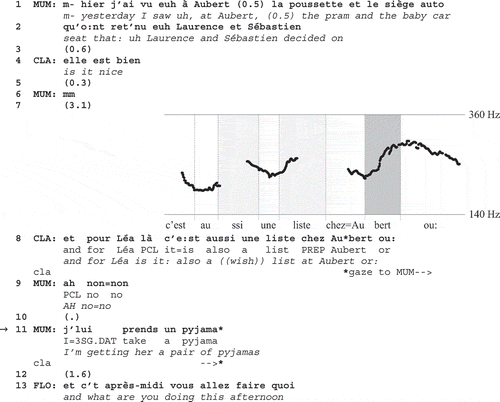
In line 4, the daughter Clarissa treats an assessment as relevant at that point by proffering a candidate one, and Mum confirms it (line 6). Clarissa then mentions another new mother, Léa, and asks whether the family is similarly buying a gift for her baby from such a list (line 8). With the et-preface and aussi (“also”), the turn is presented as initiating a sequel to the matter of the first gift (and Clarissa’s question also seems to be inferentially predicated on it). Clarissa thus nominates Mum as more knowledgeable and a prospective answerer by virtue of the participatory roles in the sequence so far. The turn is also formatted as a question through distinctly rising pitch on the major accented syllable of the declarative clauseFootnote3 (-bert), before the pitch falls on the lengthened ou: (“or:”). Furthermore, the turn-final ou: epistemically downgrades the question (cf. Drake, Citation2015) and at the same time marks the turn unambiguously as a question. Finally, Clarissa also gazes toward Mum near the end of the turn, mobilizing response from her (Rossano, Citation2012). Mum firmly disconfirms with ah non=non (line 9), then extends her turn by stating what she is getting for Léa’s daughter (line 11). Although Mum treats the gift-shopping as partly the business of the whole family, by reporting to the others (lines 1–2), she shoulders particular responsibility by being the one to do the reporting, and Mum’s special authority is crystallized in her response to Clarissa’s question. While the possibility brought up by Clarissa is categorically ruled out by Mum, Mum does not treat this as something that Clarissa could or should know, since the response elaboration is framed in the first-person singular (“I” rather than “we”). Mum thus takes upon herself the primary responsibility for knowing about (and deciding on) the matter. It is from this epistemic high ground that Mum dismisses out of hand the hypothesis that is being disconfirmed, treating it as not even remotely right. Thus, ah-prefacing is used here for presenting the answer as obvious from the answerer’s perspective, without for that matter sanctioning the questioner for failing to take into account something that she should know.
Another instance of ah-prefacing is shown in Extract 2, from a conversation among three friends. Justine launches a new topic with a question (line 1) about the others’ opinions of a concert that the participants went to the day before. Justine’s turn has phrasal rather than clausal syntax and becomes recognizable as a question through rising pitch on the major accented syllable -grets (the following adverbial constituent has a narrow rise on the accented final syllable d’hier). Justine’s gaze also contributes to selecting both interlocutors as answerers: Justine sits opposite Arnaud and Albine (who are seated next to each other), and during line 1 Justine gazes first toward Arnaud and then Albine (Rossano, Citation2012).Extract 2 [rupture_0:02:14]
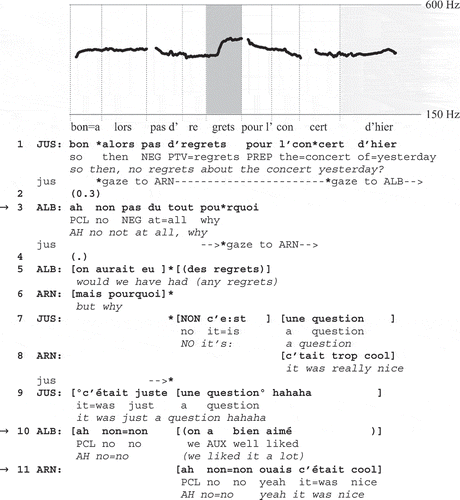
Justine’s question is first answered by Albine (line 3) with ah non, which does confirming (given the question’s negative polarity). Albine continues her turn with the fixed expression pas du tout (“not at all”), presenting the response as more categorical, and conveying that a positive response would be inconceivable here. Both Albine and her boyfriend Arnaud (lines 3–6) then elicit accounts from Justine about how she could have entertained such an idea, and Arnaud assesses the concert positively (line 8). Justine, in overlap, denies having held it as a hypothesis by labeling her own previous action (in lay terms) as merely a question (lines 7/9). In so doing, Justine renews the response relevance of her question, and both Albine (line 10) and Arnaud (line 11) reiterate the ah-prefaced negative answer first given by Albine in line 3, this time with two polar response tokens (ah non=non, see the following on multiples), before assessing the concert.
Through the (first) ah-prefaced confirmation (line 3: ah non), Albine succinctly conveys a stance toward the question that subsequently gets unpacked and elaborated: The rejected alternative (i.e., Albine and Arnaud having regrets) is unthinkable, there are no apparent reasons for considering such a possibility, and the question came “out of the blue” (cf. Heritage, Citation1998, p. 294 on oh). Like in Extract 1, ah-prefacing serves to take issue with the question by treating it as conveying some uncertainty about something indubitable. However, although Justine was at the concert, she has only indirect access to Albine’s and Arnaud’s opinions. What Justine gets sanctioned for is that she (apparently groundlessly) raises the possibility of unfavorable opinions—not that she takes an unknowing stance toward their opinions. Thus, in Extracts 1 and 2, ah-prefacing helps convey that the answer is obvious from the answerer’s perspective, although not necessarily from the questioner’s—the matter in question remains within the answerer’s domain of epistemic authority.
In response to questions where evaluative stance is relevant, ah-prefacing serves to intensify the answer and present it as upgraded relative to the terms of the question (cf. Heritage, Citation1998, p. 308 on oh-prefacing). This is apparent to some extent in Extract 2, but it becomes even clearer in cases such as Extract 3. Here, Justine is offering her guests some snacks, by stating availability (j’ai des chips crevettes [“I’ve got prawn crackers”]) and then producing a declarative-formatted candidate assessment (ça vous branche [“that interests you”]) to be confirmed by the guests. Apart from the epistemic asymmetry (Arnaud and Albine have the authority to adjudicate on their own preferences), the questionhood of the candidate assessment is recognizable from the late rising pitch contour anchored on the major accented final syllable branche and Justine’s gaze in the direction of Arnaud/Albine.Footnote4 Extract 3 [rupture_9:08]
In lines 2–3, Arnaud and Albine answer in overlap with ah-prefaced confirmations, indicating that there could be little doubt that they “are into” prawn crackers but without treating the question as querying something that should be known to the questioner. Albine also extends her answer in line 5, lexically upgrading and intensifying her stance. In overlap, Justine begins a sequence of very quick in- and outbreaths (i.e., hyperventilating), thus enacting something like excitement, on behalf of Arnaud and Albine. In third position, this enactment from Justine shows that she takes their ah-prefaced answers as strongly enthusiastic acceptances in the form of emphatic confirmations of Justine’s candidate assessment.
Ah-prefacing thus occurs in a range of answers: from cases where the rejected hypothesis is treated as not even remotely right (Extract 1), to cases where the question is treated as unexpected and the hypothesis unfounded (Extract 2), and on to cases where the answerer takes an upgraded stance relative to the terms of an otherwise apposite question (Extract 3). Across the board, through ah-prefacing, answerers treat the answer as obvious from their perspective, regardless of whether the answer is confirming or disconfirming. However, answerers do not hold questioners accountable for asking something that they should have known.
Ben-prefacing
Treating the answer as knowable to the questioner
One use of ben-prefaced answers is for indicating that the answer is known or knowable to the questioner. Extract 4 is a first illustration, where a positively framed question from Arnaud gets a ben-prefaced confirmation. Arnaud’s turn (line 13) is recognizable as a question thanks to the rising pitch contour on the accented final syllable brûle and the anaphoric connection of the pronoun ça (“that/it”) to Justine’s telling (lines 1–2), which works to position Justine as more knowledgeable.Extract 4 [rupture_0:27:48]


Arnaud’s question (line 13) is answered (after some delay) with a loud BEN OUI: and a loud nasal outbreath (i.e., a postcompletion sigh hearable as a display of resigned exasperation; cf. Hoey, Citation2014) from Justine, who also tilts her head to the side while keeping her gaze on Arnaud. All of this contributes to conveying that Arnaud’s question was inapposite and that the answer should be obvious to him (arguably from common sense alone; cf. Heritage, Citation1998, pp. 303–304 on oh-prefacing in such contexts). Albine also orients to the question as inapposite, by first telling Arnaud to stop whatever course of action he is currently pursuing (line 16), and then raising the possibility that his question might not be seriously intended (line 19).
A similar stance toward the question is displayed by the answerer in Extract 5. Here, Arnaud has just told Justine about his goth phase years ago (not shown). Justine’s visible reaction to this occurs from line 1 on.Extract 5 [rupture_0:27:00]
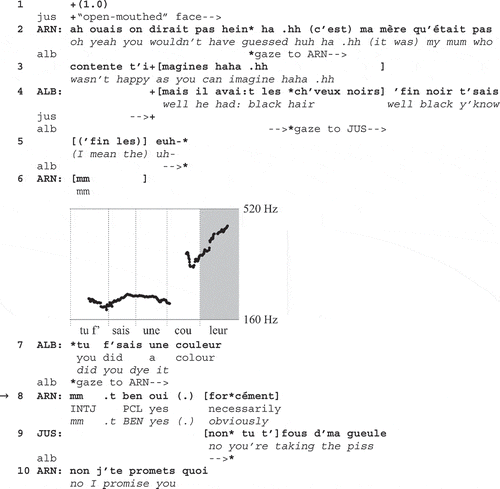
In lines 2–3, Arnaud affiliates with Justine’s display of astonishment and then extends his telling. In partial overlap (line 4), Arnaud’s girlfriend Albine assumes cotellership, addressing (and gazing toward) Justine while mentioning Arnaud’s black hair and referring to Arnaud as il (“he”). Albine begins self-repairing (lines 4–5) before breaking off, turning to gaze at Arnaud, addressing him as tu (“you”), and asking him whether he used to dye his hair (line 7). This comes off as Albine attempting to get some facts right before continuing her contribution to the telling. The questionhood of this declarative is apparent from the rising pitch over the last two syllables, and from the second-person reference, positioning Arnaud as having privileged knowledge. After a TCU (mm) that does mere and minimal confirmation, Arnaud extends his response turn with ben oui and then further with forcément (“obviously”). In line 9, Justine verbalizes her stance of astonishment at Arnaud’s disclosure, thus moving away from the side sequence between Albine and Arnaud. Consequently, Albine never resumes her contribution, abandoned in line 5.
As further unpacked through the turn extension forcément, the ben-prefaced confirmation is used for enacting an epistemic stance of self-evidence (cf. Heritage, Citation1998): Since Arnaud’s current, presumably natural hair color (brownish) is apparent, Albine could be expected to conclude that when his hair was black, it was because he dyed it. This particular matter is thus treated as knowable not only to Arnaud (who has the most direct knowledge) but also to Albine, considering the background knowledge available to her.
As shown in the extracts thus far, both ah-prefacing and ben-prefacing contribute to treating the answer as obvious, and in both cases, the alternative ratified by the answer is treated as the only conceivable one. However, ah-prefaced and ben-prefaced (dis)confirmations differ in terms of who (claimably) has the rights and responsibilities to know and pronounce themselves on what is being asked. This holds across the collection. In Extract 1, the gift planning is treated as primarily knowable to Mum, and in Extract 2, the opinion about yesterday’s concert held by Albine and Arnaud (as a single party) is unsurprisingly treated as primarily knowable to them. Similarly, in Extract 3, Albine and Arnaud are unremarkably construed as authorities on their own food preferences. By contrast, in Extract 4, the knowable is treated as a matter of common sense, rather than one about which Justine has privileged knowledge, and in Extract 5 Albine is vulnerable to the charge of not taking into account what she should know. Throughout the collection, some lexical items recurrently appear together with ah-prefaced and ben-prefaced (dis)confirmations respectively and appear to reflect the distinct epistemic stances. Ah-prefacing patterns with expressions of categoricalness like pas du tout (“not at all”) (see Extract 2), with intensifying expressions like grave (“like crazy; totally”) (see Extract 3), and with markers of certainty like c’est sûr (“that’s for sure”); sûrement (pas) (“certainly [not]).” Ben-prefacing regularly occurs together with the expression forcément (“obviously,” lit. “necessarily”)—see Extract 5—which serves to indicate self-evidence when accompanying an answer. Such lexical evidence strengthens the argument that ah-prefacing a polar answer fulfills the task of claiming the answer to be indubitable from the answerer’s own (more knowledgeable) perspective, while ben-prefacing it instead conveys that the questioner should know themselves (without asking), thus instead downplaying the epistemic asymmetry invoked through the question.
Disaligning with the wider action implications of the question
In the cases of ben-prefacing considered thus far, the question is primarily occupied with seeking information, and ben-prefacing contributes to a particular epistemic stance. When questions are asked in the service of other actions, ben-prefacing works differently: It then serves to push back not so much against the questioner’s unknowing stance but rather against the further action implications of the question, i.e., what is being done through the question. This is shown in Extracts 6 and 7.
In Extract 6, from a radio phone-in show, the caller, Ana, comes on the air just as the outro tune begins to fade in, meaning that the show is about to end, and this call will have to be closed down prematurely. Thus, the host’s turn in line 5 is not merely information seeking but initiating the closing of the call. The turn is recognizable as a question due to its overt reference to the addressee’s sensorial experience (falling within her domain of epistemic authority), and the rising-falling pitch accent on the major accented syllable -rrière.Extract 6 [mouv14-04_1:53:35]
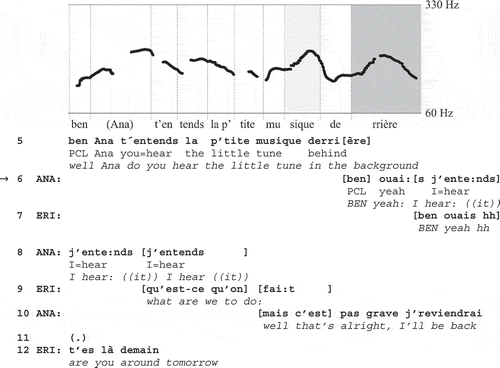
Near the end of a first possible TCU in Ana’s response (ben ouais, line 6), Éric comes in in overlap to receipt the answer with an other-repetition (line 7). With her ben ouais, Ana goes along with the question enough to produce a confirmation—thus admitting to hearing the tune—but without helping to move the pre-closing along toward terminal exchanges (as would, e.g., ouais and commenting on how the discussion could be resumed at another time). In fact, Éric subsequently treats Ana’s response as (at least “for show”) opposing the pre-closing initiation when he also refrains from taking the next step in the closing: Instead, Éric laments the early closure to which the interaction is inevitably headed with qu’est-ce qu’on fai:t (“what are we to do”) (line 9), thus further stalling the pre-closing and orienting to its undesirability. This is evidence that Ana’s ben-prefaced confirmation is heard as disaligning with the further action implications of Éric’s question (i.e., the initiation of the pre-closing). Finally, having absolved Éric, it is Ana who resumes forwarding the pre-closing with a proposal of new arrangements (j’reviendrai [“I’ll be back”]).
In Extract 7, incidentally from the same radio show, the disalignment vis-à-vis the question’s action implications is also manifested as disattending the response relevancies beyond confirmation. Here, the host greets a new caller (Flavien) but puts him on hold for the upcoming news segment, to be presented by Guillaume.Extract 7 [mouv13-04_1:25:38]
Éric points out in line 8–9 that Guillaume (present in the radio studio) is amused, which makes it apparent to the radio audience, but also generates an opportunity for Guillaume to respond. Guillaume in line 10 partially recycles Éric’s turn from line 4–5, thus making explicit what his stance was targeting. Guillaume produces his turn with wide pitch span and a rising pitch contour on the main accented syllable foo-, indicating surprise or disbelief, and prefaces the infinitive phrase with the emphatic second-person pronoun toi, thus treating it as unexpected that Éric, specifically, should talk about footballFootnote5 (Persson, Citationin press). This turn design serves to make relevant not only confirmation but confirmation followed by an account or some other acknowledgment of the putatively out-of-the-ordinary nature of what is confirmed (Persson, Citationin press). Thus, this question is done in service of another action than mere confirmation seeking. However, Éric responds (line 10) by standing his ground and confirming without going along with the further action implications of Guillaume’s question. By prefacing his oui with ben, Éric makes his confirming response come off as indeed opposing the proposed relevance of an account; this response could perhaps be glossed as “yes, why should I not?” Guillaume then continues his challenging course of action by further verbalizing his disbelief (line 12), and Éric maintains his position, enlisting Flavien to testify to its veracity (lines 13–14), still withholding any account.
The work done through ben-prefaced (dis)confirmations thus largely depends on the action that the question itself conveys: It is quite different in cases where the question is understood as primarily information seeking (Extracts 4 and 5), compared with cases where the question is treated as information seeking or confirmation seeking in the service of some other action (Extracts 6 and 7). In the former cases, the answerer treats the answer as obvious to the questioner. In the latter cases, participants go along with all the presuppositions, assumptions, epistemic implications, and formal constraints embodied in the question and provide a polar response but nonetheless take issue with the question’s agenda.
Multiple sayings: Treating the answer as redundant or doing “assuring”
Respondents do not only select among alternative practices of the same kind (particle prefaces) for pushing back somehow against a question. A third practice considered here, relying not on a particular form but on a particular grammatical operation, is the production of multiples of polar response tokens oui/ouais/non/si (i.e., reduplication, triplication, etc.). The preceding extracts have already illustrated this. For instance, in Extract 2 (lines 10 and 11), both Albine and Arnaud produce the response token non twice (ah non=non). Note that these reduplicated responses occur in a second round of responding to Justine’s original question in line 1 (prompted by Justine’s subsequent labeling of it as a question, in lines 7 and 9). The first response from Albine (line 3), by contrast, has a single non. The second-round responses can be seen as fitted to their sequential environment thus: Through the doing of two tokens, respondents display that they are currently saying something for the second time, i.e., reiterating a response already given. Thus, respondents fulfill the expectation of a polar response while simultaneously presenting that response as reasserting something the interlocutor has already heard.
This arguably iconic use of reduplication, with two tokens (in a group) produced in response round number two,Footnote6 is commonplace in the collection. It is illustrated also in Extract 8, where some friends are having predinner drinks, and Julie asks about the dinner arrangements. After a self-repair (line 1–2), her declaratively formatted turn in line 2 is recognizable as a question because of the domain of knowledge it refers to (the addressee’s recent actions), the upstep in pitch on the major accented syllable -sto, and the question-tag non (confirmation with oui remains the preferred answer).Extract 8 [pois_0:08:13]
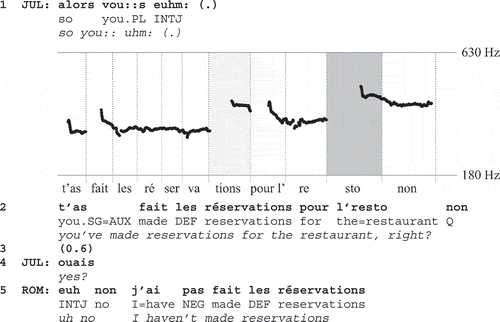
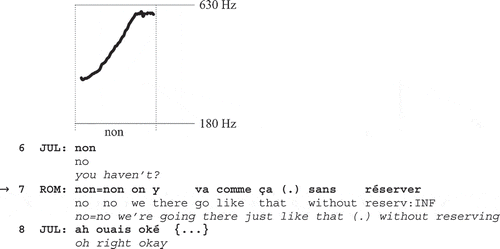
Following a brief delay (line 3), Julie offers the candidate answer ouais (“yes”) (line 4). Romain begins his turn in line 5 with euh (“uh”), which may indicate an upcoming dispreferred response, then continues with a single disconfirming non and the negated clause j’ai pas fait les réservations (“I haven’t made reservations”). Julie repeats non (line 6) with a rising pitch contour, thus seeking confirmation of what Romain just said. Romain confirms (line 7), thus doing a second round of answering, with a reduplicated non=non and elaborates on this by providing an account for not having made reservations (Romain intended for them to go without reservations, so there was no need for him to make one). Finally, Julie receipts this (line 8).
This use of reduplication amounts to something that might be glossed as “insistent” confirmation, as if the respondent’s point did not “sink in” the first time around. The pattern fits nicely with Stivers’s (Citation2004) analysis of multiple sayings addressing the prior turn as an instantiation of an ongoing larger course of action, which has persisted beyond what was warranted. By doing multiple polar response tokens, respondents treat the initiating action as the nth time they are made to answer, suggesting that they “have been over this” and that the matter has been dealt with more than necessary. This amounts to taking issue with the question in a different way, compared with ah- and ben-prefacing.
Similarly to second-round responses, reduplicated polar response tokens are also commonly used where participants reassert what they have previously asserted, as in Extract 9. Here, Julie is doing an extended telling about the situation at her boyfriend Laurent’s workplace, involving a great deal of overtime, which has taken its toll on the working environment.Extract 9 [pois_0:19:15]
Romain’s ah ouais (line 5) is hearable as a formulaic newsmark, seeking confirmation. It is the sequential placement of this formulaic expression (i.e., following a recognizable informing) that provides for its interpretation as a confirmation-seeking question, rather than its pitch contour (falling pitch on the second, accented syllable) or the gaze pattern. In response, Julie confirms with ouais=ouais before taking an inbreath and beginning to extend the telling (line 6). However, Anne comes in with an account (line 7) explaining the hostilities with tiredness, and Julie abandons her turn. While Julie’s ouais=ouais is not a reconfirmation of a previous answer to a question, it is still sequentially “nonfirst” insofar as she is now reasserting what she had previously asserted, and the reduplication serves to index that redundancy (cf. Heritage, Citation1998, pp. 297–299, on oh-prefaced responses doing just that). In the context of informings targeted by confirmation-seeking questions, reduplicated confirmation can thus be heard as insisting on the veracity of what was already said, as if to dispel any doubt (however ritualized) embodied in the confirmation-seeking question (Persson, Citationin press).
As seen, doing multiple tokens may convey the sequential property of nonfirstness, that something is said for the second (or nth) time. However, this only partially accounts for multiple sayings of polar response tokens. In Extract 10, the answerer (Laurent) gives two triplicated answers that do not reassert something previously stated. The couple Julie and Laurent (and their two guests) are heading out for dinner: Julie is in the entrance getting ready, and Laurent is waiting in the corridor just outside the open apartment door.Extract 10 [chat_31:35]
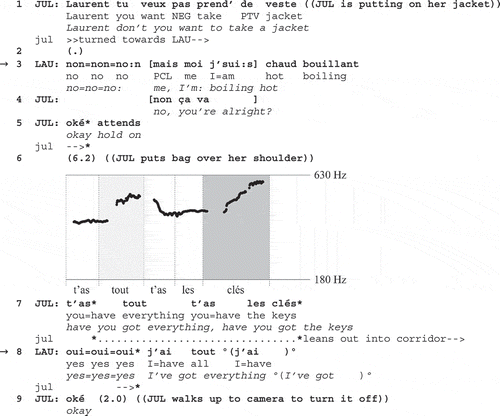
Julie’s declarative in line 1 is recognizable as a (negatively framed) question, since it refers to matters within Laurent’s domain of authoritative knowledge (his wants and decisions), and it also has rising pitch on the accented final syllable veste.Footnote7 Laurent first confirms with a triple non=non= non (line 3) and then gives an account for not needing what Julie suggested that he might want to bring. Launching the next sequence, Julie produces a two-unit question (line 7), where both turn-components are declaratives referring to matters within Laurent’s domain of epistemic authority (what objects he has on his person), each with a rising pitch accent on the last syllable (tout and clés respectively); the turn is accompanied by bodily orientation toward Laurent. This question is answered with a triple oui=oui=oui followed by repetitional confirmation (j’ai tout [“I’ve got everything”]) and something partly inaudible. On both occasions, Laurent provides answers that are seemingly given “for the first time.” One might thus ask what role the multiple saying plays in such cases. It could still be argued that there is continuity with the nonfirst uses of multiple polar response tokens, where the answer is presented as redundant. That is, in first-time answers, doing multiples of polar response tokens may amount to treating the answer as a tacitly understood state of affairs (although not an explicitly stated one or one that is inferable from prior talk). Recurrently, this happens where the question is hearable as voicing some concern or apprehension on the part of the questioner. In Extract 10, Julie’s first question (line 1) is hearable as worrying on Laurent’s behalf, and Laurent’s response turn as a whole (line 3) seems designed to do “assuring” and convey that Julie is needlessly concerned about whether Laurent has enough clothes—needlessly since as a competent member, Laurent’s dressing that way tacitly provides for the assumption that he has reasons, best known to him, for not bringing a jacket. Indeed, Laurent’s account invokes reasons known to him (mais moi j’sui:s chaud bouillant [“me I’m boiling hot”]) rather than mutually knowable reasons (e.g., it being warm outside). Similarly, Julie’s second questioning turn (line 7) is built to seek confirmation from Laurent that he has everything he is responsible for having, and she gives “the keys” as an example of things he might not have thought of bringing. With oui=oui= oui (line 8), Laurent again does “assuring” and displays that the question raises an unwarranted concern. He thereby implies that Julie does not need to remind him of his responsibilities or monitor his fulfillment of them, as though his performing of his own responsibilities went without saying. Had Laurent instead produced a single oui, he would thereby have bought fully into the question and acknowledged the well-foundedness of the question and Julie’s concern.
We now return to Extract 1, where Clarissa’s question gets a reduplicated first-time answer (ah non=non) from Mum. While the ah-prefacing serves to make the disconfirmation more categorical, and defend some epistemic territory, the multiple saying is used for a subtly different task: to do “assuring” (i.e., indicating that the matter is already in hand, as Mum’s turn expansion makes clear), similarly to what is achieved with the multiple in Extract 10.
At times, multiples of polar response tokens are used for doing “assuring” also in cases of nonfirst answers; see Extract 11. Sylvie and Élodie are on the phone making arrangements to meet in the city later and deciding on where to park. They have business in two places in the city, and in line 1 Sylvie is asking whether one (the station) is far from the other (a store near which they also plan to park). The question voices some apprehension insofar as a longer distance might mean more difficulties for the participants, e.g., having to walk far or driving between the two places and finding parking near each of them.Extract 11 [FTELPV06_3:03]
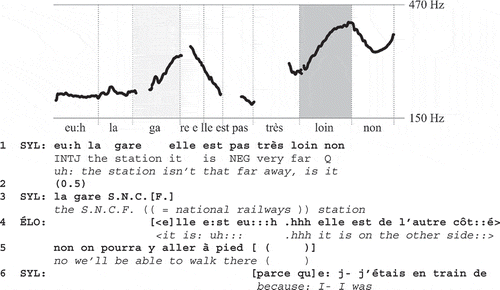
Sylvie’s negatively framed turn (line 1) is recognizable as a question thanks to a wide rising pitch contour on the major accented syllable loin and thanks to the question-tag non (which has a narrower falling-rising contour). After some delay, Sylvie repairs her question by specifying the place reference (line 3). Élodie first produces line 4 slowly and with sound stretches, to display mentally retrieving an answer. Then (line 5), she begins the answer proper with a single confirming non, followed by an elaboration that answers the question not in terms of distance strictly speaking but feasibility of walking, thus orienting to an inferred purpose for asking. Sylvie then (lines 6–8) details her partial knowledge of the matter (line 9 is a continuer produced by Élodie during Sylvie’s turn), and the assertion in line 8 works as a confirmation-seeking question thanks to its epistemic downgrading (j’ai l’impr’ssion … [“I have the impression … ”]). This question can also be taken as a reiteration of the question in line 1, and Élodie responds with a reduplicated confirming non followed by an elaboration, this time put in terms of proximity. Through reduplication, Élodie thus presents her answer in line 10 as redundant and as reiterating her first answer (line 5), which began with a single non. However, in the face of Sylvie’s hearably apprehensive questioning, Élodie’s reduplicated answer simultaneously serves to do “assuring” and indicate that there is no need to be concerned regarding this matter. Finally, Sylvie produces another confirmation-seeking newsmark (line 12: ouais) with falling-rising pitch—and Élodie confirms with reduplication again (line 14: ouais=ouais), again presenting her answer as redundant. Only then does Sylvie produce a sequence-closing third (line 15).
Much like in Extract 11, the hearably concerned questioning in Extract 8 also provides for the understanding of the multiple saying as doing “assuring” and downplaying Julie’s concern (about possibly not getting a table), in addition to indexing the nonfirstness and redundancy of the confirmation.
In sum, in nonfirst answers, multiple sayings of polar response tokens index the very property of sequential nonfirstness, i.e., that the (dis)confirmation is a redundant reiteration of a prior response or assertion. In first-time answers (and in some nonfirst), multiples are used to do “assuring,” i.e., display that the question voices an unnecessary concern or apprehension.
Concluding discussion
Having examined three practices for taking issue with a question while answering it, it is relevant to ask how they differ from nonconforming responses. Nonconforming responses appear to be used to resist the terms of the question and the constraints placed on the answer (i.e., resisting the answerability of the question in the terms proposed, by altering those terms). By contrast, this study suggests that particle-prefaced and multiplied polar response tokens are deployed to take issue with the askability of the question (i.e., assert the “unquestionability” of the answer). Previous work has also illustrated that nonconforming responses allow participants to disalign with the further action implications of questions by way of deflecting the course of action they propose (Bolden, Citation2018; G. Raymond, Citation2003; Stivers & Hayashi, Citation2010). By contrast, this study indicates that ben-prefaced polar responses also serve to disalign with the further action implications of questions, but to a lesser degree—that is, deflecting the course of action to a lesser extent.
Another question pursued here is how the interactional work accomplished through prefatory particles relates to whatever semantic meaning (itself sedimented from numerous particularized uses) they exhibit. I argue that with the particle ah, like other change-of-state tokens, the producer generically communicates a self-attentive shift of focus, associated with the indexing of interactionally relevant aspects of the speaker’s state of mind. In polar response prefaces, this results in the stance that the answer is obvious from the answerer’s perspective. The continuities with other uses of ah (signaling informativeness, realization, recollection, etc.) reside in this change-of-state semantics.
As for ben (much like for English well; Heritage, Citation2018), it is more difficult to find a semantic core meaning common to the various uses, even when restricting the scope to response-prefatory position. A somewhat better account is possible in terms of a procedural (or “pragmatic”) core meaning: Ben projects the problematizing of some aspect(s) of the prior turn and the canceling of expectations and projections associated therewith. However, more commonalities are apparent in sequences where knowledge imbalances are claimed: Much like ben-prefacing an answer (in question-answer sequences) can mark the answer as self-evident and already known, ben-prefacing a receipt of an informing serves to treat that informing as already known.
To be sure, this study does not cover all possible practices for taking issue with a question while answering it—only three vital ones—and similar restrictions apply to available work on other languages. Some cross-linguistic comparisons are nevertheless possible, regarding how these three practices serve to perform different aspects of a more general interactional task (taking issue with a prior question), considered in relation to the work achieved through practices described for other languages. In English, oh-prefacing an answer can serve to claim epistemic primacy through a self-attentive shift of focus to the answerer’s perspective (Heritage, Citation1998, pp. 295–296). But oh-prefacing is also deployed in answers conveying putatively known-to-questioner information (Heritage, Citation1998, p. 302). Thus, English oh-prefacing subsumes both the more self-attentive “obvious-to-me” uses and the more sanctioning “obvious-to-me-and-you” uses, which are distinguished by ah- and ben-prefacing. The French ah/ben contrast actually presents some resemblance to the division of labor between the Japanese prefatory particles a and eh: Whereas a treats the question as unexpected and possibly far off the mark but legitimate, eh more strongly problematizes the question and treats it as inapposite in terms of relevance or assumptions about knowledge distribution (Hayashi & Hayano, Citation2018). Finally, multiple sayings of polar response tokens in French appear to cover some tasks performed through multiple sayings in English (displaying redundancy of an action responded to, when it is nonfirst in a larger course of action; Stivers, Citation2004), some tasks for which oh-prefacing is used (presenting the answer as redundant, given what has been said in previous talk; Heritage, Citation1998, pp. 297–299), and yet other tasks for which, to our knowledge, no dedicated practice has been identified (doing “reassuring” and displaying that the question raises an unwarranted concern).
In conclusion, some practices for problematizing an initiating action seem more generic, leaving more of the interactional work to be specified through local particularization, by reference to sequential position, the nature of the initiating action, and the characteristics of the response turn itself (e.g., Heritage, Citation2018, on oh-prefacing; Bolden, Citation2018, on nu-prefacing in Russian). By contrast, the practices investigated here are more specialized, insofar as they differentiate different sorts of issues that the respondent has with the question. Nonetheless, some aspects of the question responded to have been identified as consequential. For instance, ah-prefacing works more like intensification the more the question is implicative of evaluative stance. For ben-prefacing, it is crucial whether the question is primarily information seeking or done in the service of some other action. Finally, for multiple sayings, it matters whether the response asserts something for the first time or not, and whether the question is hearable as voicing concern. While of course an indefinite number of contextual and compositional particulars are drawn upon by participants for making sense of each instance—indeed, the significance of the in-situ particularization cannot be overstated—these are some identified systematic ways in which position (in addition to composition) plays a role in these practices.
Correction Statement
This article has been republished with minor changes. These changes do not impact the academic content of the article.
Additional information
Funding
Notes
1 Precisely what counts as a prosodic unit takes varies from one language to another, since their prosodic systems are different to begin with. In French, the prosodic unit takes the form of a stress group (see footnote 2). Furthermore, nonfinal tokens often have reduced articulatory gestures.
2 Stress groups are identifiable as stretches of talk with perceptible stress on the final full syllable of the last word, mainly involving lengthening of the syllable rhyme and often more dynamic pitch movements.
3 The first turn-component et pour Léa là cannot be analyzed for speech characteristics, as the recording has been anonymized during the name.
4 It is difficult to determine who Justine is gazing at, since the two are at roughly the same angle from Justine’s position at this point.
5 On many previous occasions, Éric has expressed a lack of interest in professional football.
6 Participants sometimes continue this pattern when a sequence is extended to a third round of responding: three tokens (i.e., triplication) when saying something for the third time.
7 Julie has also turned to Laurent, but her eyes are not visible to the camera.
References
- Bolden, G. B. (2009). Beyond answering: Repeat-prefaced responses in conversation. Communication Monographs, 76(2), 121–143. https://doi.org/10.1080/03637750902828446
- Bolden, G. B. (2016). A simple da? Journal of Pragmatics, 100, 40–58. https://doi.org/10.1016/j.pragma.2015.07.010
- Bolden, G. B. (2018). Nu-prefaced responses in Russian conversation. In Heritage & Sorjonen (Eds.), Between turn and sequence: Turn-initial particles across languages (pp. 25–58). Benjamins.
- Bruxelles, S., & Traverso, V. (2001). Ben: Apport de la description d’un ‘petit mot’ du discours à l’étude des polylogues. Marges Linguistiques, 2, 38–55. http://www.revue-texto.net/Parutions/Marges/00_ml112001.pdf
- Dostie, G. (2012). Ben en tant que collocatif discursif. Travaux De Linguistique, 65(2), 105–122. https://doi.org/10.3917/tl.065.0105
- Drake, V. (2015). Indexing uncertainty. Research on Language and Social Interaction, 48(3), 301–318. https://doi.org/10.1080/08351813.2015.1058606
- Enfield, N. J., & Sidnell, J. (2015). Language structure and social agency. Linguistics Vanguard, 1(1), 131–143. https://doi.org/10.1515/lingvan-2014-1008
- Fauré, L. (1997). Les interjections à l’oral. Cahiers de Praxématique, 28, 127–148. http://journals.openedition.org/praxematique/3052
- Hayashi, M., & Hayano, K. (2018). A-prefaced responses to inquiry in Japanese. In Heritage & Sorjonen (Eds.), Between turn and sequence: Turn-initial particles across languages (pp. 193–223). Benjamins.
- Heinemann, T. (2009). Two answers to inapposite inquiries. In J. Sidnell (Ed.), Conversation analysis: Comparative perspectives (pp. 159–186). Cambridge University Press.
- Heinemann, T., Lindström, A., & Steensig, J. (2011). Addressing epistemic incongruence in question-answer sequences through the use of epistemic adverbs. In T. Stivers, L. Mondada, & J. Steensig (Eds.), The morality of knowledge in conversation (pp. 107–130). Cambridge University Press.
- Heritage, J. (1984). A change-of-state token and aspects of its sequential placement. In J. M. Atkinson & J. Heritage (Eds.), Structures of social action (pp. 299–345). Cambridge University Press.
- Heritage, J. (1998). Oh-prefaced responses to inquiry. Language in Society, 27(3), 291–334. https://doi.org/10.1017/S0047404500019990
- Heritage, J. (2013). Turn-initial position and some of its occupants. Journal of Pragmatics, 57, 331–337. https://doi.org/10.1016/j.pragma.2013.08.025
- Heritage, J. (2015). Well-prefaced turns in English conversation. Journal of Pragmatics, 88, 88–104. https://doi.org/10.1016/j.pragma.2015.08.008
- Heritage, J. (2018). Turn-initial particles in English. In Heritage & Sorjonen (Eds.), Between turn and sequence: Turn-initial particles across languages (pp. 155–189). Benjamins.
- Heritage, J., & Raymond, G. (2012). Navigating epistemic landscapes. In J. P. de Ruiter (Ed.), Questions (pp. 179–192). Cambridge University Press.
- Heritage, J., & Sorjonen, M.-L. (Eds). (2018). Between turn and sequence: Turn-initial particles across languages. Benjamins.
- Hoey, E. (2014). Sighing in interaction. Research on Language and Social Interaction, 47(2), 175–200. https://doi.org/10.1080/08351813.2014.900229
- Kerbrat-Orecchioni, C. (1991). Introduction. In C. Kerbrat-Orecchioni (Ed.), La question (pp. 5–37). PUL.
- Kim, M. S. (2013). Answering questions about the unquestionable in Korean conversation. Journal of Pragmatics, 57, 138–157. https://doi.org/10.1016/j.pragma.2013.08.004
- Kim, S. H. (2013). Reshaping the response space with kulenikka in beginning to respond to questions in Korean conversation. Journal of Pragmatics, 57, 303–317. https://doi.org/10.1016/j.pragma.2013.04.006
- Kim, S. H. (2015). Resisting the terms of polar questions through ani (‘no’)-prefacing in Korean conversation. Discourse Processes, 52(4), 311–334. https://doi.org/10.1080/0163853X.2014.954950
- Kim, S. H. (2018). Two types of trouble with questions. In Heritage & Sorjonen (Eds.), Between turn and sequence: Turn-initial particles across languages (pp. 97–117). Benjamins.
- Laforest, M. (1992). Le back-channel en situation d’entrevue. CIRAL.
- Lee, S.-H. (2013). Response design in conversation. In J. Sidnell & T. Stivers (Eds.), The handbook of conversation analysis (pp. 415–432). Wiley-Blackwell.
- Mondada, L. (2009). The embodied and negotiated production of assessments in instructed actions. Research on Language & Social Interaction, 42(4), 329–361. https://doi.org/10.1080/08351810903296473
- Mondada, L. (2011). The management of knowledge discrepancies and of epistemic changes in institutional interactions. In T. Stivers, L. Mondada, & J. Steensig (Eds.), The morality of knowledge in conversation (pp. 27–57). Cambridge University Press.
- Morel, M.-A., & Danon-Boileau, L. (2001). Les productions sonores de l’écouteur du récit. Revue Québécoise de Linguistique, 29(1), 71–95. https://doi.org/10.7202/039430ar
- Mosegaard Hansen, M.-B. (1998). The function of discourse particles. Benjamins.
- Pekarek Doehler, S. (2016). More than an epistemic hedge. Journal of Pragmatics, 106, 148–162. https://doi.org/10.1016/j.pragma.2016.06.014
- Pekarek Doehler, S., & Horlacher, A.-S. (2015). Grammaire émergente, grammaire pour l’interaction. In X. Gradoux, J. Jacquin, & G. Merminod (Eds.), Agir dans la diversité des langues (pp. 139–151). Louvain-la-Neuve: De Boeck Supérieur.
- Persson, R. (2015). Indexing one’s own previous action as inadequate. Language in Society, 44(4), 497–524. https://doi.org/10.1017/S004740451500041X
- Persson, R. (in press). Prosody and grammar of other-repetitions in French. Language in Society. https://doi.org/doi:10.1017/S0047404520000068
- Raymond, C. W. (2018). Bueno-, pues-, and bueno-pues-prefacing in Spanish conversation. In Heritage & Sorjonen (Eds.), Between turn and sequence: Turn-initial particles across languages (pp. 59–96). Benjamins.
- Raymond, G. (2003). Grammar and social organization. American Sociological Review, 68(6), 939–967. https://doi.org/10.2307/1519752
- Rossano, F. (2012). Gaze behaviour in face-to-face interaction. Radboud Universiteit.
- Schegloff, E. A. (1996). Confirming allusions. American Journal of Sociology, 102(1), 161–216. https://doi.org/10.1086/230911
- Sorjonen, M.-L. (2001). Responding in Conversation. Benjamins.
- Stivers, T. (2004). ‘No no no’ and other types of multiple sayings in social interaction. Human Communication Research, 30(2), 260–293. https://doi.org/10.1111/j.1468-2958.2004.tb00733.x
- Stivers, T. (2011). Morality and question design: “Of course” as contesting a presupposition of askability. In T. Stivers, L. Mondada, & J. Steensig (Eds.), The morality of knowledge in conversation (pp. 82–106). Cambridge University Press.
- Stivers, T., & Enfield, N. J. (2010). A coding scheme for question-response sequences in conversation. Journal of Pragmatics, 42(10), 2620–2626. https://doi.org/10.1016/j.pragma.2010.04.002
- Stivers, T., & Hayashi, M. (2010). Transformative answers. Language in Society, 39(1), 1–25. https://doi.org/10.1017/S0047404509990637
- Thompson, S. A., Fox, B. A., & Couper-Kuhlen, E. (2015). Grammar in everyday talk. Cambridge University Press.
- Weidner, M. (2018). Treating something as self-evident. In Heritage & Sorjonen (Eds.), Between turn and sequence: Turn-initial particles across languages (pp. 225–250). Benjamins.
- Wu, R.-J., & Heritage, J. (2017). Particles and epistemics. In G. Raymond, G. H. Lerner, & J. Heritage (Eds.), Enabling human conduct (pp. 273–298). Benjamins.

